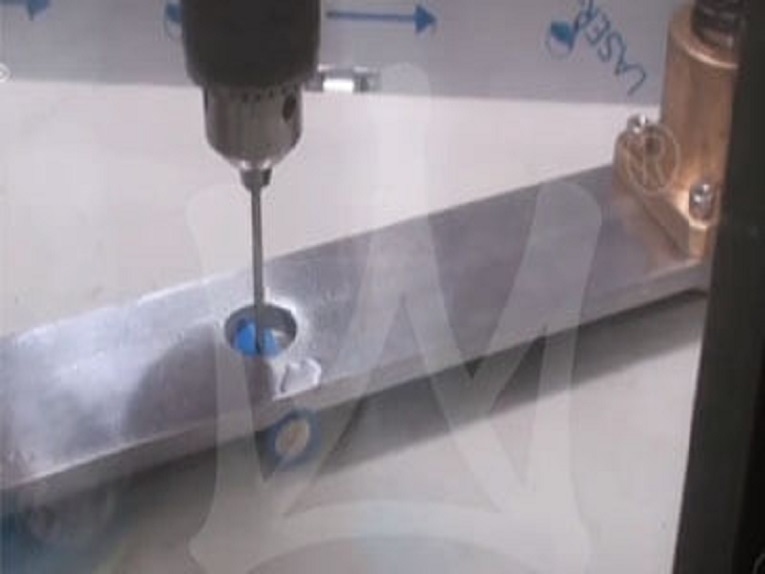
#Industry News
Why Do We Need To Do The Nail Penetration Test?
Why Do We Need To Do The Nail Penetration Test?
The Nail Penetration Test, an internal short circuit test method, is a safety test that tests the internal short circuit tolerance of lithium-ion batteries.
The Needle Penetration Test is a test that uses a steel nail through the battery to simulate an internal short circuit to confirm whether the battery is smoking, catching fire, or breaking. In addition, the needling test is not only a test to confirm the safety of the battery, but also a test to understand the basic nature of the battery.
In the normal state, the positive and negative electrode sheets of a lithium-ion battery are insulated by a polymer insulating film - the diaphragm - in the organic electrolyte. In this state, a steel nail is inserted in the lithium-ion battery to create a short circuit between the positive and negative electrode plates, forcing an internal short circuit test. The test method is characterized by the ability to adjust the test conditions such as the diameter, material, insertion depth, insertion position and insertion speed of the steel nail inserted inside the battery.
The Dangers of Nail Penetration
The need for lithium-ion batteries to be tested with a pinprick means that they are extremely susceptible to internal short-circuiting and will be in a very dangerous condition if a short-circuit occurs. Lithium-ion batteries have the characteristics of high energy density, low internal resistance, and high allowable through-current, making them very dangerous. Generally speaking, an internal short circuit occurs during the use of the battery because the manufacturing process is mixed with conductive foreign matter, or by external impact or stress.
In reality, once the product is manufactured, it is difficult to take measures for internal short circuits in the control system, including battery charging and discharging, and circuitry. When an internal short circuit occurs, the battery passes a huge short-circuit current internally, which subsequently generates Joule heat, and this heat, in turn, causes the combustible organic electrolyte to react and produce high-temperature gases, resulting in an increased likelihood of thermal runaway.
When thermal runaway occurs, smoke, fire. In severe cases, rupture occurs, endangering the personal safety of the user. From the user's point of view, it is important to ensure the safety of the battery for the application of lithium-ion batteries Pinprick testing uses steel nails inserted inside the battery to create an internal short circuit between the positive and negative electrodes in a relatively simple manner. However, when the nail is inserted into the battery to form a perforation on the surface of the battery, this hole will release high temperature gas, resulting in a change in the internal heat dissipation state of the battery, and there may be differences from the actual internal short circuit situation.
Short circuit test without forming perforations and no gas ejections
It is called Blunt Nail Test (BNT). This method creates a short circuit between the electrode materials (positive and negative electrode sheets) of the battery by the pressure of the nail, and the battery is only slightly deformed after the test. Compared with the usual pinprick test, this method can create a state that is closer to the actual internal short circuit.
Preparation of the experimental setup
To perform this test, manually driving a nail into a lithium-ion battery is definitely not an option and should not be attempted lightly - the nail could fly out and cause injuries to hands and body. Therefore, it is necessary to build a pinning test machine. Using a commercially available benchtop hand press (hydraulic pump required separately, maximum pressure 4000kg, stroke 120mm, stroke extension 250mm long), a nail penetration tester was made that can fit 3 diameters of steel nails (φ3mm, φ5mm, φ8mm, 100mm long). Or you can purchase DGBELL's nail penetration tester directly, and DGBELL's nail penetration tester can be manufactured according to your requirements.
Safety measures
Considering the safety, you should make sure the tester can be operated from a certain distance, install the hydraulic pump elsewhere, and add a nail insertion jig to the head of the stroke extension bar to fix different size nails. Insert the nail into the fixture, adjust the position and then use the bolt to fix it. The speed of nail insertion, after several manual hydraulic tests, we obtained the result of about 0.7mm/s by measuring the stroke and movement time.
Test summary
The positive and negative battery terminals were connected to an oscilloscope through an observation probe to observe the voltage waveform. The waveform was observed using a general-purpose memory recorder (Nikkei Electric 8855 model), and the observation probe was connected to the voltage and current unit (8951) installed in the memory recorder.
Related notes
Here, we test three different types of stacked batteries (300mA-h, 1000mA-h, 2000mA-h). The data to be measured are as follows.
- Battery terminal voltage variation over time
- Temperature of the cell surface presented by thermal imaging
- Changes in the appearance and shape of the battery after needling (confirmed by the naked eye) Before conducting the experiment, carefully prepare fire prevention measures and safety measures: prevent splashes, shade the area around the test machine, place a fire extinguisher nearby, etc.
Measurement of the voltage waveform
For batteries with different capacities, use steel nails of different diameters for the pinprick test. The change of terminal voltage over time was measured after the nail penetration test of a 2000mA-h laminated battery using a φ5mm steel nail.
Differences caused by needling conditions
Including the above test results, the following facts are known based on the results of several experiments.
(1) At the point of needling, the terminal voltage drops sharply and gradually decreases to 0V, and the voltage curve fluctuates sharply when the voltage drops to a certain level.
(2) The test results of different battery types and needling conditions vary during the phase from the point of needling to the large change in terminal voltage, but the terminal voltage drops to 0V after 10 to 20s.
(3) For the same capacity battery, the thicker the pinning, the greater the change in terminal voltage when conducting the test. Battery surface temperature measurement After pinning, the change in surface temperature of the laminated battery with time can be measured by infrared thermography. The change in surface temperature measured when the 2000mA-h laminated battery is pinpointed using a steel nail of φ5mm.
Temperature rise after needling The temperature exceeded 200°C during the needling test of a 2000mA-h stacked cell using a φ5mm steel nail. In the test on the 1000mA-h battery sample, a fire occurred when a φ3mm nail was used. In the pin prick test with a φ5mm nail, the fire was observed and the battery temperature increased significantly. Moreover, the maximum temperature measured was below 100°C for different cells.
Although the tester is not a commercial level and can only be used for experimental purposes, it is possible to perform pinprick tests on batteries using this tester. It is also possible to use a general-purpose memory recorder, a digital oscilloscope, and an infrared thermal imaging camera to measure the voltage and temperature of the battery terminals after needling. This test, by short-circuiting the positive and negative terminals, instantly converts the electrical energy stored inside the battery.





